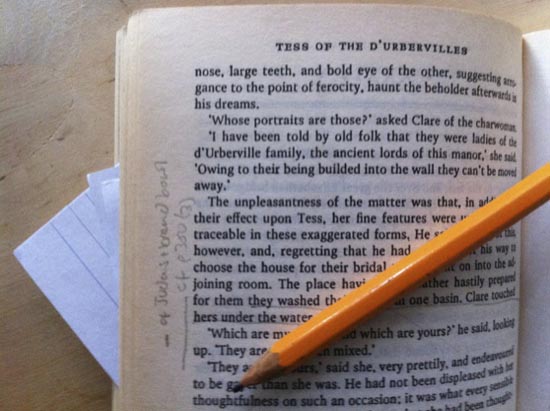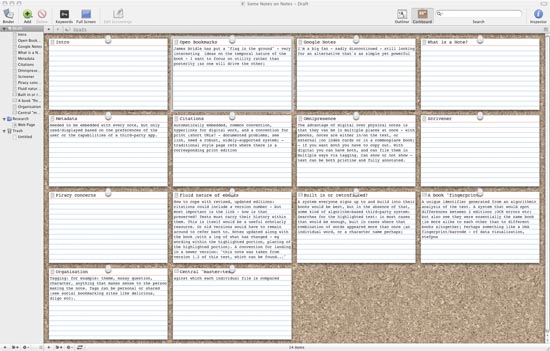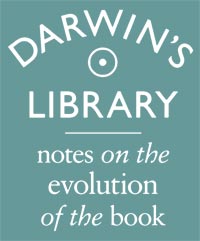Some notes on notes: part one

I have a collection of battered Penguin Classics from my student days. They are full of underlinings and jottings in the margin where I’ve identified passages pertinent to a particular essay question. For a long time, I also kept envelopes stuffed with small pieces of paper, on which I had transcribed the relevant passages, along with similar notes from other sources and my own thoughts. I used these makeshift index cards to structure my essays, the writing of which would require transcribing once again any quotations I wanted to include.
In a world of digital text, there really ought to be an easier way. A better way.
And yet, not all ebook platforms support annotation. And those that do, tend to do so in ways that are incompatible with each other, or keep the notes restricted to the confines of their walled gardens. Gathering, storing, using and sharing notes from multiple sources remains far too laborious.
James Bridle has put a flag in the ground with his fledgling Open Bookmarks project. His essay offers a thoughtful perspective on the book as a temporal object, and how annotation can bring this function into the digital realm. Here I’m going to add my own thoughts on the utility of a digital annotation system – how it might be used and how it might work.
The Web leads the way
Like many of the technical problems that trouble ebooks, the question of notes has already been substantially addressed by the web. Social bookmarking sites like Diigo and Delicious make it very easy to capture, annotate and archive material from around the web. For a long time, my favourite online tool was Google Notebook, the now tragically discontinued notes and clippings service. This isn’t the place to wax lyrical about GNote’s many benefits, or the brain-twisting time I’ve had trying to replace it. Suffice it to say that among it’s many charms was a quick and simple web clipper. With minimal fuss, a passage of text or an image on a website could be highlighted and clipped to a Notebook. A link back to the original page was included automatically, and additional notes and tags could be added.
This is very much the kind of thing I’d like to see for ebooks – in fact, I’d like to see the same tool work for both ebooks and the web, because in this as in many other contexts, there is no meaningful distinction between them.1
What is a note?
In the physical world, a note may be a section of text highlighted or underlined, and/or an annotation added in the margin, or at the back of a book, or captured somewhere external to the book (for instance, in a commonplace book, on an index card, or in a file (physical or electronic). These annotations may refer specifically to a word or passage, or more generally to a chapter, section or the entire book. In the electronic world, we should be able to make, store, use and share notes containing excerpted text (or pictures, video or audio for that matter), our own annotations, and a reliable reference back to the source.
At its most basic, this requires the ability to highlight and copy text, and automatically embed metadata about the source.
For academic use, a proper citation will be required, and the metadata contained within a note should be robust enough to serve that need. It should include title, author, publisher and edition, along with an indicator of the position within the text (the equivalent of a page reference). For citations in electronically published works, a hyperlink would best serve the latter purpose. A short URL service could form the basis of a convention for citing ebooks in print.2 For editions with a print equivalent, an actual page reference could also be included, though this would be more of an optional extra than a core requirement, since there will not always be an equivalent publication in print.
The best of both worlds
With pbooks, annotation can be a divisive subject. Some people highlight, underline, dog-ear and scrawl on the pages while others can’t bear the idea of defacing their books, and make their notes somewhere external.3 There are pros and cons to both approaches. Directly annotated books provide a useful reminder when rereading, but can get in the way if you want to experience the text afresh; those battered Penguins of mine are a great window back to my years of study, but if I ever want to read Tess of the D’Urbevilles for pleasure, the last thing I want is a text filtered through a list of essay questions.4 External notes require passages to be transcribed, and the notes themselves need filing, but can be used more flexibly and in combination with notes relating to other books or sources. A digital notes system ought to be able to combine the best elements of both. Notes and highlights (ones own or those shared by others) could be displayed on top of the text, or hidden; Each note should, without the need for duplication of effort on the part of the reader making the note, also exist as a discrete external entity that can be viewed and used alongside notes from multiple sources.
I wrote this post in much the same way as I did my student essays – with each point on a separate card, which I then rearranged into (I hope) a coherent argument. The difference is that I did all that on screen, using Scrivener.5

A notes system that covered the basics (text clipping and metadata to identify the source) could be made into a truly rich resource by third party products. An app like Scrivener could potentially allow me to import quotes from ebooks, and add properly-formatted citations as end notes. Tools could be developed to clip sections of audio and video along with metadata identifying the source. All my notes from myriad electronic media could be stored alongside each other, organised with cross-referencing hyperlinks and a flexible tagging system. The possibilities for note-sharing and collaborative work are immense. Once extracted from (but forever linked to) their point of origin, notes could be used in many more imaginative ways than I can think of. We just need the tools to set them free. Open Bookmarks may well provide those tools.
In Part 2, I’ll look at some of the barriers to an open notes and bookmarks system, and how they might be overcome.
- I’m not talking about technical differences, which are many, vexatious, and largely artificial. I’m talking about the common sense view that any digital text may contain a nugget of information I want to clip, save and use elsewhere. [↩]
- There is some legitimate concern around the longevity of URL-shortening services, so this would have to be something robust; with the backing of publishers and academic institutions, this ought to be easily achievable. [↩]
- Again, James Bridle has some interesting thoughts on this. [↩]
- With this problem in mind, I made most of my notes in pencil, with the intention of erasing them at a later date. That’ll definitely happen. [↩]
- A lovely writing project management tool for Mac and – soon – Windows. [↩]



[...] time? The utility-defying page edge metaphor in iBooks for example [↩]Some Notes on Notes Part One & Part Two [↩]Assuming, that is, that Amazon hasn’t found some ingenious way to patent [...]